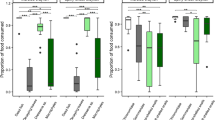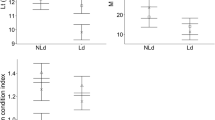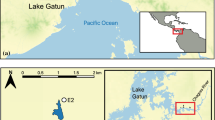Abstract
The signal crayfish (Pacifastacus leniusculus) was introduced to Crater Lake in 1915 and now threatens the local extinction of an endemic salamander, the Mazama newt (Taricha granulosa mazamae). More than a century after their introduction, crayfish have expanded in distribution to occupy nearly 80% of the lakeshore. Although newts remain in uninvaded areas, they are almost entirely absent in crayfish occupied areas. Abundance of benthic macroinvertebrates was dramatically reduced in locations with crayfish compared with areas of the lake where crayfish were absent. Isotopic signatures of newt and crayfish tissue confirm overlap in the diets of the two species and demonstrate their similar position in the Crater Lake food web. Mesocosm experiments conducted with newts and crayfish revealed that crayfish prey directly on newts, displace newts from cover, and generally alter newt behavior. Combined, this evidence suggests that further crayfish expansion likely will cause additional declines in newt abundance and distribution, and could lead to extinction of the unique population of newts in Crater Lake.









Similar content being viewed by others
References
Aquiloni L, Becciolini A, Berti R, Porciani S, Trunfio C, Gherardi F (2009) Managing invasive crayfish: use of X-ray sterilization of males. Freshw Biol 54:1510–1519
Axelsson E, Nyström P, Sidenmark J, Brönmark C (1997) Crayfish predation on amphibian eggs and larvae. Amphibia-Reptilia 18:217–228
Bacon CR (1983) Eruptive history of Mount Mazama and Crater Lake caldera, Cascade Range, USA. J Volcanol Geotherm Res 18:57–115
Bacon CR, Gardner JV, Mayer LA, Buktenica MW, Dartnell P, Ramsey DW, Robinson JE (2002) Morphology, volcanism, and mass wasting in Crater Lake, Oregon. Geol Soc Am Bull 114(6):675–692
Beebee TJ, Griffiths RA (2005) The amphibian decline crisis: a watershed for conservation biology? Biol Conserv 125(3):271–285
Bernardo JM, Costa AM, Bruxelas S, Teixeira A (2011) Dispersal and coexistence of two non-native crayfish species (Pacifastacus leniusculus and Procambarus clarkii) in NE Portugal over a 10-year period. Knowl Manag Aquat Ecosyst 401:28
Bjurström L, Ruokonen T, Pursiainen M, Jones RI, Hämäläinen H (2010) Impacts of the invasive signal crayfish on littoral macroinvertebrates of large boreal lakes: a pilot study in Lake Päijänne, Finland. Freshw Crayfish 17:177–182
Blaustein AR, Chivers DP, Kats LB, Kiesecker JM (2000) Effects of ultraviolet radiation on locomotion and orientation in roughskin newts (Taricha granulosa). Ethology 108:227–234
Boss ES, Collier R, Larson G, Fennel K, Pegau WS (2007) Measurements of spectral optical properties and their relation to biogeochemical variables and processes in Crater Lake, Crater Lake National Park, OR. Hydrobiologia 574:149–159
Brode JS (1938) The denizens of Crater Lake. Northwest Sci 12:50–57
Brodie ED Jr (1968) Investigations on the skin toxin of the adult rough-skinned newt, Taricha granulosa. Copeia 1968:307–313
Bubb DH, Lucas MC, Thom TJ (2002) Winter movements and activity of signal crayfish Pacifastacus leniusculus in an upland river, determined by radio telemetry. In: Aquatic telemetry, pp 111–119. Springer, Netherlands
Bubb DH, Thom TJ, Lucas MC (2004) Movement and dispersal of the invasive signal crayfish Pacifastacus leniusculus in upland rivers. Freshw Biol 49(3):357–368
Buktenica MW, Girdner SF, Larson GL, McIntire CD (2007) Variability of kokanee and rainbow trout food habits, distribution, and population dynamics, in an ultraoligotrophic lake with no manipulative management. Hydrobiologia 574:235–264
Burnham KP, Anderson DR (2003) Model selection and multimodel inference: a practical information-theoretic approach. Springer, New York
Burnham KP, Overton WS (1979) Robust estimation of population size when capture probabilities vary among animals. Ecology 60(5):927–936
Cardall BL, Brodie ED, Hanifin CT (2004) Secretion and regeneration of tetrodotoxin in the rough-skin newt (Taricha granulosa). Toxicon 44(8):933–938
Collins JP, Storfer A (2003) Global amphibian declines: sorting the hypotheses. Divers Distrib 9(2):89–98
Cruz M, Rebelo R, Crespo EG (2006) Effects of an introduced crayfish, Procambarus clarkii, on the distribution of south-western Iberian amphibians in their breeding habitats. Ecography 29(3):329–338
Dorn NJ, Wojdak JM (2004) The role of omnivorous crayfish in littoral communities. Oecologia 140(1):150–159
Dudgeon D, Arthington AH, Gessner MO, Kawabata ZI, Knowler DJ, Lévêque C, Naiman RJ, Prieur-Richard AH, Soto D, Stiassny ML, Sullivan CA (2006) Freshwater biodiversity: importance, threats, status and conservation challenges. Biol Rev 81(2):163–182
Farner DS (1947) Notes on the food habits of the salamanders of Crater Lake, Oregon. Copeia 1947:259–261
Farner DS, Kezer J (1953) Notes on the amphibians and reptiles of Crater Lake National Park. Am Midland Nat 50:448–462
Fitzsimons JD, Jonas JL, Claramunt RM, Williston B, Williston G, Marsden JE, Ellrott BJ, Honeyfield DC (2007) Influence of egg predation and physical disturbance on lake trout Salvelinus namaycush egg mortality and implications for life-history theory. J Fish Biol 71(1):1–16
Flint RW, Goldman CR (1975) The effects of a benthic grazer on the primary productivity of the littoral zone of Lake Tahoe. Limnol Oceanogr 20(6):935–944
Francesco Ficetola G, Siesa ME, Manenti R, Bottoni L, De Bernardi F, Padoa-Schioppa E (2011) Early assessment of the impact of alien species: differential consequences of an invasive crayfish on adult and larval amphibians. Divers Distrib 17(6):1141–1151
Fry B (1991) Stable isotope diagrams of freshwater food webs. Ecology 72(6):2293–2297
Gamradt SC, Kats LB (1996) Effect of introduced crayfish and mosquitofish on California newts. Conserv Biol 10(4):1155–1162
Gamradt SC, Kats LB, Anzalone CB (1997) Aggression by non-native crayfish deters breeding in California newts. Conserv Biol 11(3):793–796
Gherardi F, Aquiloni L, Diéguez-Uribeondo J, Tricarico E (2011) Managing invasive crayfish: Is there a hope? Aquat Sci 73:185–200
Gomez-Mestre I, Díaz-Paniagua C (2011) Invasive predatory crayfish do not trigger inducible defenses in tadpoles. Proc R Soc B 278:3364–3370
Guan RZ, Wiles PR (1999) Growth and reproduction of the introduced crayfish Pacifastacus leniusculus in a British lowland river. Fish Res 42(3):245–259
Halliday TR, Worsnop A (1977) Correlation between activity and breathing rate in the smooth newt, Triturus vulgaris (Amphibia, Urodela, Salamandridae). J Herpetol 11(2):244–246
Hangui JI, Wakahara M, Michimae H (2009) Plastic responses to different types of cue: predator-induced and deep-water-induced polyphenisms in a salamander Hynobius retardatus. Zool Sci 26(2):119–124
Hanson CC, Jolley WJ, Smith G, Garcelon DK, Keitt BS, Little AE, Campbell KJ (2015) Feral cat eradication in the presence of endemic San Nicolas Island foxes. Biol Invasions 17(4):977–986
Hargreaves BR, Gardiner SF, Buktenica MW, Collier RW, Urbach E, Larson GL (2007) Ultraviolet radiation and bio-optics in Crater Lake, Oregon. Hydrobiologia 574:107–140
Hobbs HH, Jass JP, Huner JV (1989) A review of global crayfish introductions with particular emphasis on two North American species (Decapoda, Cambaridae). Crustaceana 56(3):299–316
Hudina S, Faller M, Lucić A, Klobučar G, Maguire I (2009) Distribution and dispersal of two invasive crayfish species in the Drava River basin, Croatia. Knowl Manag Aquat Ecosyst 394–395:09
Jackson AL, Inger R, Parnell AC, Bearhop S (2011) Comparing isotopic niche widths among and within communities: SIBER–Stable Isotope Bayesian Ellipses in R. J Anim Ecol 80(3):595–602
Johnson MF, Rice SP, Reid I (2014) The activity of signal crayfish (Pacifastacus leniusculus) in relation to thermal and hydraulic dynamics of an alluvial stream, UK. Hydrobiologia 724(1):41–54
Kirjavainen J, Westman K (1999) Natural history and development of the introduced signal crayfish, Pacifastacus leniusculus, in a small, isolated Finnish lake, from 1968 to 1993. Aquat Living Resour 12(6):387–401
Larson ER, Olden JD (2012) Crayfish occupancy and abundance in lakes of the Pacific Northwest, USA. Freshw Sci 32(1):94–107
Larson ER, Olden JD (2016) Field sampling techniques for crayfish. In: Longshaw M, Stebbing P (eds) Biology and ecology of crayfish. CRC Press, Boca Raton, FL, pp 287–324
Larson GL, Collier R, Buktenica MW (2007) Long-term limnological research and monitoring at Crater Lake, Oregon. Hydrobiologia 574(1):1–11
Layman CA, Arrington DA, Montaña CG, Post DM (2007) Can stable isotope ratios provide for community-wide measures of trophic structure? Ecology 88(1):42–48
Light T (2003) Success and failure in a lotic crayfish invasion: the roles of hydrologic variability and habitat alteration. Freshw Biol 48:1886–1897
Lodge DM, Hill AM (1994) Factors governing species composition, population size, and productivity of coolwater crayfishes. Nord J Freshw Res 69:111–136
Lodge DM, Lorman JG (1987) Reductions in submersed macrophyte biomass and species richness by the crayfish Orconectes rusticus. Can J Fish Aquat Sci 44(3):591–597
Lodge DM, Kershner MW, Aloi JE, Covich AP (1994) Effects of an omnivorous crayfish (Orconectes rusticus) on a freshwater littoral food web. Ecology 75(5):1265–1281
Lodge DM, Taylor CA, Holdich DM, Skurdal J (2000) Reducing impacts of exotic crayfish introductions. Fisheries 25(8):21–23
Lodge DM, Deines A, Gherardi F, Yeo DC, Arcella T, Baldridge AK, Barnes MA, Chadderton WL, Feder JL, Gantz CA, Howard GW (2012) Global introductions of crayfishes: evaluating the impact of species invasions on ecosystem services. Annu Rev Ecol Evol Syst 43:449–472
Lozán JL (2000) On the threat to the European crayfish: a contribution with the study of the activity behavior of four crayfish species (Decapoda: Astacidae). Limnologica 30(2):156–161
Mazerolle MJ (2011) AICcmodavg: model selection and multimodel inference based on (Q) AIC (c). R package version, 1(1.15)
Mccarthy JM, Hein CL, Olden JD, Jake Vander Zanden M (2006) Coupling long-term studies with meta-analysis to investigate impacts of non-native crayfish on zoobenthic communities. Freshw Biol 51(2):224–235
Myers GS (1942) Notes on Pacific coast Triturus. Copeia 2:77–82
Nyström P, Brönmark C, Granéli W (1999) Influence of an exotic and a native crayfish species on a littoral benthic community. Oikos 85:545–553
Olden JD, McCarthy JM, Maxted JT, Fetzer WW, Vander Zanden MJ (2006) The rapid spread of rusty crayfish (Orconectes rusticus) with observations on native crayfish declines in Wisconsin (USA) over the past 130 years. Biol Invasions 8(8):1621–1628
Olsson K, Stenroth P, Nyström PER, Granéli W (2009) Invasions and niche width: Does niche width of an introduced crayfish differ from a native crayfish? Freshw Biol 54(8):1731–1740
Parnell A, Jackson A (2013) SIAR: stable isotope analysis in R. R package version 4.2. http://CRAN.R-project.org/package=siar, 23 Mar 2014
Pearl CA, Adams MJ, Schuytema GS, Nebeker AV (2003) Behavioral responses of anuran larvae to chemical cues of native and introduced predators in the Pacific Northwestern United States. J Herpetol 37:572–576
Peay S, Guthrie N, Spees J, Nilsson E, Bradley P (2009) The impact of signal crayfish (Pacifastacus leniusculus) on the recruitment of salmonid fish in a headwater stream in Yorkshire, England. Knowl Manag Aquat Ecosyst 394–395:12
Perry WL, Feder JL, Dwyer G, Lodge DM (2001) Hybrid zone dynamics and species replacement between Orconectes crayfishes in a northern Wisconsin lake. Evolution 55(6):1153–1166
R Core Team (2016) R: a language and environment for statistical computing. R Foundation for Statistical Computing, Vienna, Austria. http://www.R-project.org/
Riley SP, Busteed GT, Kats LB, Vandergon TL, Lee LF, Dagit RG, Kerby JL, Fisher RN, Sauvajot RM (2005) Effects of urbanization on the distribution and abundance of amphibians and invasive species in southern California streams. Conserv Biol 19(6):1894–1907
Rosewarne PJ, Piper AT, Wright RM, Dunn AM (2013) Do lowhead riverine structures hinder the spread of invasive crayfish? Case study of signal crayfish (Pacifastacus leniusculus) movements at a flow gauging weir. Manag Biol Invasions 4(4):273–282
Spurway H, Haldane JBS (1954) The comparative ethology of vertebrate breathing. Behaviour 6(1):8–34
Stebbing P, Longshaw M, Scott A (2014) Review of methods for the management of non-indigenous crayfish, with particular reference to Great Britain. Ethol Ecol Evol 26(2–3):204–231
Stenroth P, Nyström P (2003) Exotic crayfish in a brown water stream: effects on juvenile trout, invertebrates and algae. Freshw Biol 48(3):466–475
Stokes AN, Ray AM, Buktenica M, Gall BG, Paulson E, Paulson D, French SS, Brodie ED III, Brodie ED Jr (2015) Otter predation on Taricha granulosa and variation in tetrodotoxin levels with elevation. Northwestern Nat 96(1):13–21
Tapley B, Bradfield KS, Michaels C, Bungard M (2015) Amphibians and conservation breeding programmes: Do all threatened amphibians belong on the ark? Biodivers Conserv 24(11):2625–2646
Tierney AJ, Godleski MS, Massanari JR (2000) Comparative analysis of agonistic behavior in four crayfish species. J Crustacean Biol 20(1):54–66
Twardochleb LA, Olden JD, Larson ER (2013) A global meta-analysis of the ecological impacts of nonnative crayfish. Freshw Sci 32(4):1367–1382
Unnamed author 1915 Aug 1. Must feed fishes: officials at Crater Lake confronted with scarcity of fish food. Ashland Record
Unnamed author 1915 Aug 20. Crayfish are planted: commission provides for trout in Diamond and Crater Lakes. Oregonian
Usio N, Kamiyama R, Saji A, Takamura N (2009) Size-dependent impacts of invasive alien crayfish on a littoral marsh community. Biol Conserv 142(7):1480–1490
van der Wal JE, Dorenbosch M, Immers AK, Forteza CV, Geurts JJ, Peeters ET, Koese B, Bakker ES (2013) Invasive crayfish threaten the development of submerged macrophytes in lake restoration. PLoS ONE 8(10):e78579
Vander Zanden MJ, Rasmussen JB (1999) Primary consumer δ13C and δ15N and the trophic position of aquatic consumers. Ecology 80(4):1395–1404
Westman K, Savolainen R, Julkunen M (2002) Replacement of the native crayfish Astacus astacus by the introduced species Pacifastacus leniusculus in a small, enclosed Finnish lake: a 30-year study. Ecography 25(1):53–73
Wilson NJ, Williams CR (2014) A critical review of freshwater crayfish as amphibian predators: capable consumers of toxic prey? Toxicon 82:9–17
Wilson KA, Magnuson JJ, Lodge DM, Hill AM, Kratz TK, Perry WL, Willis TV (2004) A long-term rusty crayfish (Orconectes rusticus) invasion: dispersal patterns and community change in a north temperate lake. Can J Fish Aquat Sci 61(11):2255–2266
Wilson NJ, Stokes AN, Hopkins GR, Brodie ED Jr, Williams CR (2014) Functional and physiological resistance of crayfish to amphibian toxins: tetrodotoxin resistance in the white river crayfish (Procambarus acutus). Can J Zool 92(11):939–945
Zippel K, Johnson K, Gagliardo R, Gibson R, McFadden M, Browne R, Martinez C, Townsend E (2011) The Amphibian Ark: a global community for ex situ conservation of amphibians. Herpetol Conserev Biol 6(3):340–352
Acknowledgements
Research of crayfish and newts in Crater Lake was supported by the National Park Service, Crater Lake National Park, the U.S. Geological Survey Park Oriented Biological Support Program, and the University of Nevada, Reno (UNR).
Author information
Authors and Affiliations
Corresponding author
Rights and permissions
About this article
Cite this article
Girdner, S.F., Ray, A.M., Buktenica, M.W. et al. Replacement of a unique population of newts (Taricha granulosa mazamae) by introduced signal crayfish (Pacifastacus leniusculus) in Crater Lake, Oregon. Biol Invasions 20, 721–740 (2018). https://doi.org/10.1007/s10530-017-1570-6
Received:
Accepted:
Published:
Issue Date:
DOI: https://doi.org/10.1007/s10530-017-1570-6




